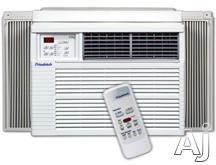
Air conditioner thoughts. Not sure if needed since this is mainly storage shed, but well insulated, white metal roof, etc. Also only intend to only have off grid solar power (though with 2000W sine wave inverter for short duration usage...to possibly power air conditioner for 30 minutes while finding a box, that is one goal). AC present motor load which is infamously bad for small inverters, but a 1000 or 2000W inverter *ought* to be able to do it (some reports of success, but generally also with large battery arrays which I won't have).
Do not want to waste main window, or have second window only for AC. So main plan was through wall air conditioner. Most window AC units assume double hung window. Those windows are pricey and much less available than single hung and often not very energy efficient.
Of course Ronnie said he could do through wall AC installation.
Two options are possible for through wall installation. One is to use actual "through wall" air conditioner. With those, you buy a sleeve separately. The lowest BTU through wall unit is a GE with 6400 BTU at $413 through AJ Madison, cheapest sleeve for that is $59. If you buy the GE sleeve you can use one of several GE models with increasing BTU capacity. For most other manufacturers, 8000 BTU is the minimum for through-wall. Many through-wall units offer heat pump heat (at higher price than cool only, of course).
But another approach is to have slide-out chassis air conditioner. Such units allow both window and wall installation, plus the convenience of slide-out for repair (?). These seem to be more generally available in lower capacities than through wall units, and don't require sleeve. Based on square footage, insulation, and limited capacity of solar power, I want something like 5,000 BTU. Here is one that fits the bill perfectly (though much higher priced than typical window units):
Friedrich XQ05M10 (for $440.10 at Madison.com).
This model specifies 4.5 amps (though intended for 15A circuit), 491 watts. Width 22-30 inches, height 14 inches, heavy 70 pounds for mere 5500 BTU (other such units weigh as little as 41 pounds).
Now this does no heating (maybe that's what through wall units do). Doesn't say anyting about fan to bring in fresh air (those are said not to work very well generally).
Another approach is "in room air conditioner" that uses small venting ducts, like this one by Friedrich.
These tend to only be available in higher capacities than through wall units, but there is a 5000 BTU unit by Danby. Big advantage here is that hole or holes through wall can be fairly small, and don't need special framing as is required for through wall installations. Also, these units don't need to drain outside (which can cause foundation damage if not done 5 feet from slab). Also you can aim the thing right where you are. Disadvantage is few low BTU options, the only 5000 BTU unit is made by Danby and requires 5.8 nameplate amps (as compared with 5500 Friedrich slide-out unit that only needs 4.5 amps).
For window units, and possible the above also, one issue raised by Consumer Reports is how well cold air can be directed left or right. Many units seem to have a particular problem with directing cold air to the right (which is what I need). In fact, the Friedrich CP06F10 was bad at directing air either left or right. The best tested for right and left airflow was cheapie Frigidaire FRA054XT7 which otherwise got lowest rating of those listed in 2011 buying guide (not much lower than others), and runner up was top rated and expensive Haier ESAD4066.
But the main storage issue might be humidity. Humidity is mainly a problem at night when temperature falls, then there can be condensation on cool surfaces. Especially on floor (no boxes should rest on floor). It would be possible (I suppose) to get small room dehumidifier. Those actually heat a bit since no heat goes outside. But maybe just the ticket for preventing condensation when it's cold. Same motor load and power issues as with window AC, possibly less so however for small units, so possibly couldn't run long enough during cold night to help.
Another approach to condensation control might be to run small fans, easily done with solar power. Also, small amounts of heat could be generated with light bulbs or equivalent (big resistors?).
Anyway, now that I'm going with fiber cement siding, which I think can be fairly easily modified by any qualified contractor, I think I'll forego the air conditioner. It's just not part of my plan really (someone said I must have it, but they aren't thinking about this building as I am...it's not intended to be a general purpose living space or clubhouse. It could be a clubhouse on pleasant afternoons and evenings, likewise workshop, etc. But otherwise, I don't want air conditioning because I don't want this building to be energy hog. But I was worried that with brick I should think of every eventuality and prepare for it in advance. Though, as it turns out, even brick walls can have window additions, as they say, it's done every day.
In principle, a sleeve could be installed for future A/C addition. But it seems each AC manufacturer has their own unique sleeve, and if I buy a sleeve today, it might not work with AC unit I want in the future. Plus having extra hole in the wall increases energy loss, and raises the possibility of leakage and other problems, in addition to being ugly.

No comments:
Post a Comment